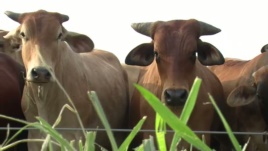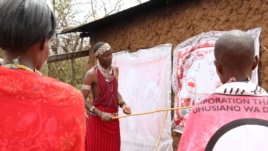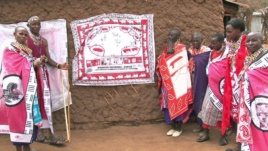VOA慢速英语:越来越多的疾病是动物传染给人类的!
By VOA
05 January, 2014
Hello, and welcome to As It Is from VOA Learning English.
I'm Christopher Cruise in Washington.
Today on the program, we report on efforts by doctors in Kenya to end trachoma, an infectious eye disease that causes blindness.
"When I decided to go for the eye surgery, I was worried and uncomfortable. I thought after the surgery I would not see again. But now it's the opposite -- I am confident, happy and I can do my work well."
But first, we report on a warning from the United Nations that more diseases are now spreading from animals to humans.
"I think that if we continue the state of play, we'll only see more diseases emerge, more natural resources disappear, and more threats to the human health into the food chain."
Fighting the spread of diseases in Kenya and throughout the world -- that is today's subject on As It Is.
FAO: Spread of Diseases from Animals to Humans Increasing
About 70 percent of the new diseases that have infected humans in recent years have come from animals. The United Nations Food and Agriculture Organization -- or FAO -- says more diseases are moving from animals to humans as the Earth's population grows and the time and distance from when the food is harvested to when it is eaten increases.
Caty Weaver reports.
 |
| Crosses fill a graveyard in Cape Town's Khayelitsha township. Many of those buried in the South African cemetery died from AIDS or related complications such as tuberculosis. |
The FAO recently released a report called "World Livestock 2013: Changing Disease Landscapes."
Juan Lubroth is the chief officer of animal medicine at the agency.
"I think that if we continue the state of play, we'll only see more diseases emerge, more natural resources disappear, and more threats to the human health into the food chain."
Dr. Lubroth says humans are coming in contact with new diseases as they explore more parts of the world.
"We are encroaching into habitats that previously we as humans did not really know -- those ecological niches were occupied by other species, but we are invading them."
Dr. Lubroth says poor healthcare and human waste systems increase the risk of disease -- especially in areas where people do not have much money. And he says as the number of people on the planet increases, so does the number of livestock -- which causes problems.
"The origin of the human immunodeficiency virus -- HIV, which causes AIDS -- probably had its precursor in something that we know today to be simian -- or monkey -- immunodeficiency virus. And then even more recently, we have the Middle East Respiratory Syndrome, which is caused by a corona virus -- which likely has an animal origin. We are at the point in research which we still are trying to find out what origin that is."
He says other diseases that have moved from animals to humans in the past five to ten years include the Nipah and Hendra viruses, which are usually found in bats. And, of course, there is bird flu.
"Probably more familiar to your readers or listeners will be the H5N1 Avian influenza, which in 2003 spread in Southeast Asia and by 2006 was present in over 60 countries and territories."
The FAO is calling for groups of experts to work together to fight the growing disease threat. Scientists, researchers, doctors and other experts from many different areas of science and medicine would work with one another and share any discoveries.
The FAO report says this approach could help reduce poverty and reduce biological threats caused by globalization and climate change. It could also lead to better safety and health measures in livestock production.
I'm Caty Weaver.
You are listening to As It Is, a program designed to help you learn to speak, read and write American English.
Now once again here is Christopher Cruise, with a report on medical workers in Kenya who are trying to stop the spread of a disease that causes blindness...
Thanks Caty.
Kenyan Doctors Work to End Trachoma by 2020
Health care workers in Kenya say more than 60,000 people in the east African nation are living with trachoma. The infectious eye disease causes blindness if it is not treated early. VOA visited a Kenyan village where medical workers are trying to stop a spread of the disease.
 |
| Trachoma monitor Lester Mortai teaches a group women how to prevent trachoma at household level, Kajiado, Kenya. (Mohammed Yusuf for VOA) |
Kajiado is a village in a rural area of southern Kenya. A local anti-trachoma worker teaches a group of women how to stop the disease and how to treat it. Lester Mortai is well-known in this area for his work fighting trachoma. He often travels through villages, teaching people the best ways to avoid getting the painful disease.
"Visit those homesteads and tell people to go to, to prevent diseases by having their own initiative, to have that facial cleanliness -- those without trachoma and even those with trachoma."
Trachoma is caused by bacteria, and is spread by touching the infected eye or nose of a person who already has it. In developing countries, flies often spread the disease.
The African Medical and Research Foundation -- or AMREF -- says more than 7,000 people in Kajiado suffer from trachoma. People who have the disease suffer from painful swelling of the eyelid and scarring of the outer area of the eye -- called the cornea.
Ngeyan Nge has a bad case of trachoma. She will have surgery to keep her from going blind.
 |
| A woman washes her face in Kajaido, Kenya. Facial cleanliness is one way to prevent trachoma. (Mohammed Yusuf for VOA) |
"I am hopeful about the future, even though in the beginning I was opposed to the surgery. I've changed my mind after continuous advice from people."
John Soine works for AMREF. He travels to rural areas of Kenya to do surgery on people with severe cases of trachoma.
"So if these people with active infection are not treated, they end up developing complications whereby the eyelashes start facing inwards and start rubbing on the eyeball. And at this stage one may lose vision. And the loss of vision in trachoma is irreversible."
Kadogo Salaash had almost lost her vision to the disease more than five years ago. Like Ngeyan Nge, she was at first not sure surgery could help her.
"When I decided to go for the eye surgery I was worried and uncomfortable. I thought after the surgery I would not see again. But now it's the opposite -- I'm confident, happy and can do my work well."
 |
| A group of Kenyan villagers learn how to prevent trachoma and how and where to get treatment. |
With this kind of medical help -- and campaigns to educate people about trachoma in schools and in poorer communities -- Kenyan medical officials hope to greatly reduce the number of trachoma cases. They hope they can end it throughout the country by 2020.
And that's our program for today. It was written in Special English from reports by Joe De Capua in Washington and Mohammed Yusuf in Kajaido, Kenya.
I'm Christopher Cruise reporting from VOA Learning English headquarters in Washington.
- 频道推荐
- |
- 全站推荐
- 推荐下载
- 网站推荐




















